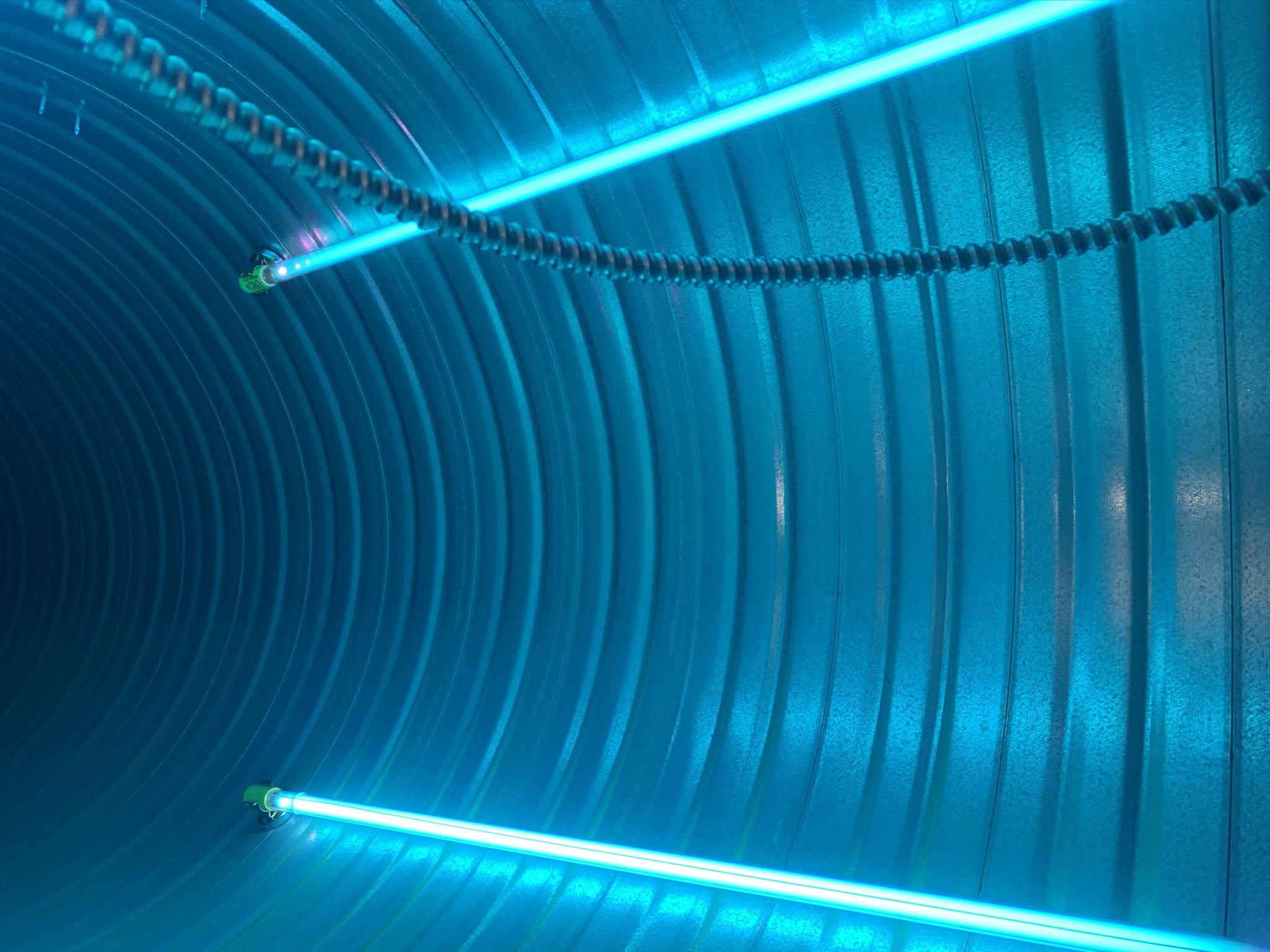
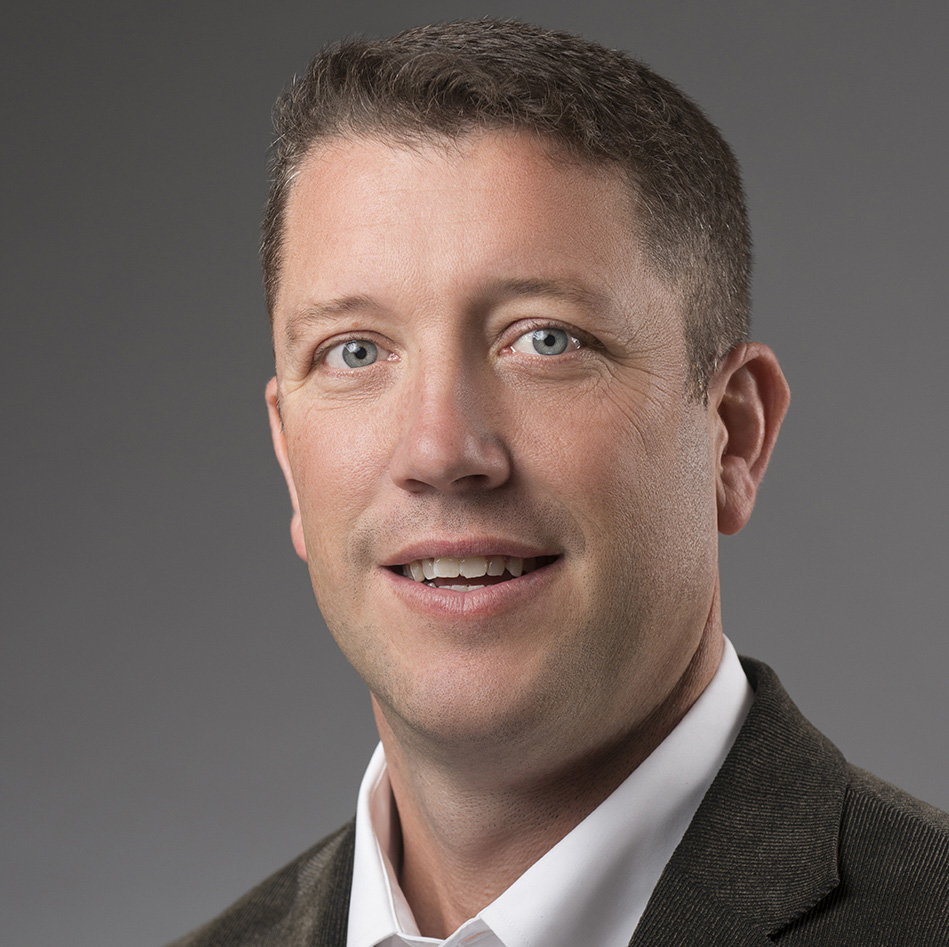 By David Van der Vossen, PE
By David Van der Vossen, PE
Senior VP of Engineering
LEED AP BD+C, CGD
In the previous blogs in the series, we reviewed increasing ventilation and filtration rates. Both are approaches that can be quickly implemented on most buildings. However, longer term strategies implementing air sanitization technologies can be more effective and bring back some of the energy savings compromised by increasing ventilation rates. The industry standard for air sanitization is Ultraviolet Germicidal Irradiation (UVGI); also frequently referred to as UVC based on the light spectrum utilized.
UVGI works by exposing pathogens to enough UVC light to break down the ladder rungs in the DNA or RNA structure to render the pathogen inert so that it cannot multiply.
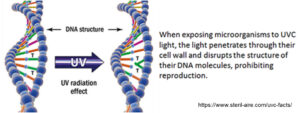
UVC sanitization has been used in water treatment since around 1910 and for air sanitization since the 1950’s. What sets UVGI apart from the other air sanitization options are the double-blind studies that have been performed. In the studies, one floor of a building was treated with UVGI and compared to the control floor which was not treated (Reference 1—ScienceDirect.com). In another study, different homeless shelters were tested using upper room UVGI (Reference 2—NIH National Institute of Health). Beneficial health outcomes were realized on the treated floor and no unintended negative health outcomes were experienced. It is these double-blind studies that has pushed UVGI to the front of the pack. Studies of air sanitization methods are typically sample room experiments in which different pathogens are placed in a room, the system is run for a given period of time and then the lower concentration of the pathogens are measured. While these sorts of studies can demonstrate effectiveness against pathogens, they do not necessarily demonstrate beneficial health outcomes. It is for this reason that the CDC says, “This is not to imply that the technology doesn’t work as advertised, only that in the absence of an established body of evidence reflecting proven efficacy under as-used conditions, the technology is still considered by many to be an “emerging technology” (Reference 3—ASHRAE Technical Resources).
The optimal wavelength for UVC to make pathogens inert is 265 nm. Low pressure mercury lamps produce the bulk of its energy at 254 nm which matches up and is about 85% of the peak effectiveness. This turns out to be the most practical lamp selection for this application.
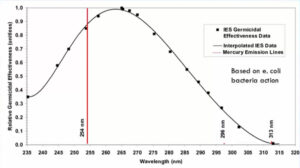
ASHRAE 2019 HVAC Applications Ch. 62.6 Figure 6
The 254 nm and 265 nm wavelengths fall into the UV-C spectrum and avoid common health and safety concerns associated with UV-A and UV-B spectrums. Sunburn and skin cancer is associated with UV-A and UV-B spectrums. This is not the case with UV-C. The wavelengths do not penetrate the upper level of dead skin cells. Eyes on the other hand are of concern and too much exposure can cause welders flash which is not permanent but should be avoided. As such, occupants and service personnel should be protected from exposure to active lamps.
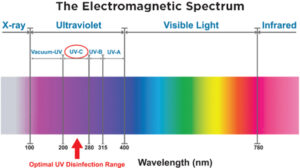
https://www.evoqua.com/en/brands/ETS_UV/Pages/how-ets-uv-works.aspx
There are two common approaches for UVGI air sanitization. The first and less common is Upper Room UVGI. In this application, lower intensity UVC lamp fixtures are placed in higher risk occupied areas such as emergency rooms of homeless shelters. Fixtures are commonly installed at seven feet above the floor and have louvers and lens that direct the light so that all light shines above a flat horizontal and avoids eye contact with occupants. Surfaces, monitors, signage and other items in the space need to be evaluated for reflectivity to ensure no UVC light is reflected down into occupants’ eyes. Since the air flow is relatively slow in the space, the wattage of the lamps can be low as the pathogens are exposed over a longer period. Most rooms will require multiple fixtures and an analysis performed with a manufacturer’s program to make sure enough fixtures are installed and spaced out correctly.
 .
. 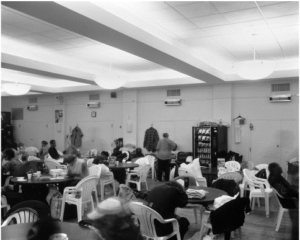
More common applications of UVGI are in unit or in duct applications. In these instances, the UVC fixtures are installed within the HVAC unit or within the ductwork. Pathogen control methodologies require sizing for “single pass kill.” These are higher wattage/doses that kill off over 99% of the pathogens in a “single pass” through the HVAC unit. Retrofitting existing equipment or ductwork may be problematic as UVC light tends to break down soft materials over time. This is similar to plastics that are exposed to sunlight. As such, satisfactory locations within units or ductwork need to be located that have a limited number of soft materials (wires, belts, gaskets, insulation) or can have the materials relocated or encapsulated. One common approach is to use foil tape to cover wires in a HVAC unit.
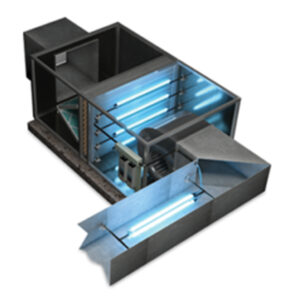
https://www.freshaireuv.com/commercial-hvac/
Referencing back to our sample project from our week 3 blog; we had upgraded the system to MERV 13 filters and had increased our outdoor air to 30% on the example day. This resulted in a very good 38% pass through rate.

However, if we install in unit UVGI and size for single-pass our pass-through rate will drop below 1%. Since the UVGI will perform the bulk of the effort in mitigating the pathogens, we can reduce the outdoor air back down to the code required ventilation rate (in this instance 15%). This will allow us to save the energy utilized in conditioning the additional outdoor air. The UVGI lamps do use energy but not to the scale of conditioning the higher volumes of outdoor air. For example, a 10-ton unit serving a typical 3,500 square foot office will use three 84-watt lamps. This is 252 watts, essentially similar to a standard desktop computer.

It is recommended to maintain the MERV 13 filters to capture the inert pathogen particles and more importantly minimize the dust on the lamps. As mentioned earlier, it does not take much to block the UVC spectrum energy, so keeping the lamps clean is important. Maintenance staff should be trained on the manufacturers recommended cleaning procedures to ensure lamp effectiveness. Typically, this involves wiping the lamp with a wet or dry microfiber cloth. Cleaning chemicals are typically not recommended as they may leave a residue that could block the UVC spectrum.
Lamp life varies between 9,000 to 12,000 hours depending on manufacturer. If run on a continuous basis, lamp life can last a little over a year. Since the lamps cost about $100 each, you can extend lamp life by running only during occupied hours by using a time clock or interlocking the lamps with a lighting circuit that is on during occupied hours. In a standard office building, this will triple the time you get out of the lamps.
Installed cost vary by application, with larger units and applications being more cost effective on a square foot basis. Typical costs range between 50 cents to $1 per square foot. This technology and price point makes it a good option to install and provide staff an increased degree in comfort to come back to an in-person work environment.
While at times it can be difficult to find an acceptable location to install UVGI, it remains an engineer’s first choice for air sanitization because of the long history and double-blind studies referenced above and that it doesn’t come with the caveats listed by ASHARE and the CDC for other air sanitization technologies.
Engineering Tomorrow
At Allen + Shariff, we believe in providing innovative and efficient MEP engineering solutions to our clients. Contact us for more information on our ongoing blog series, to participate in a registered AIA seminar, or learn more about how you can partner with our team.
Contact Dave Van der Vossen at 910-218-3856 for details.

 By David Van der Vossen, PE
By David Van der Vossen, PE
Senior VP of Engineering
LEED AP BD+C, CGD
In the previous blogs in the series, we reviewed increasing ventilation and filtration rates. Both are approaches that can be quickly implemented on most buildings. However, longer term strategies implementing air sanitization technologies can be more effective and bring back some of the energy savings compromised by increasing ventilation rates. The industry standard for air sanitization is Ultraviolet Germicidal Irradiation (UVGI); also frequently referred to as UVC based on the light spectrum utilized.
UVGI works by exposing pathogens to enough UVC light to break down the ladder rungs in the DNA or RNA structure to render the pathogen inert so that it cannot multiply.

UVC sanitization has been used in water treatment since around 1910 and for air sanitization since the 1950’s. What sets UVGI apart from the other air sanitization options are the double-blind studies that have been performed. In the studies, one floor of a building was treated with UVGI and compared to the control floor which was not treated (Reference 1—ScienceDirect.com). In another study, different homeless shelters were tested using upper room UVGI (Reference 2—NIH National Institute of Health). Beneficial health outcomes were realized on the treated floor and no unintended negative health outcomes were experienced. It is these double-blind studies that has pushed UVGI to the front of the pack. Studies of air sanitization methods are typically sample room experiments in which different pathogens are placed in a room, the system is run for a given period of time and then the lower concentration of the pathogens are measured. While these sorts of studies can demonstrate effectiveness against pathogens, they do not necessarily demonstrate beneficial health outcomes. It is for this reason that the CDC says, “This is not to imply that the technology doesn’t work as advertised, only that in the absence of an established body of evidence reflecting proven efficacy under as-used conditions, the technology is still considered by many to be an “emerging technology” (Reference 3—ASHRAE Technical Resources).
The optimal wavelength for UVC to make pathogens inert is 265 nm. Low pressure mercury lamps produce the bulk of its energy at 254 nm which matches up and is about 85% of the peak effectiveness. This turns out to be the most practical lamp selection for this application.

ASHRAE 2019 HVAC Applications Ch. 62.6 Figure 6
The 254 nm and 265 nm wavelengths fall into the UV-C spectrum and avoid common health and safety concerns associated with UV-A and UV-B spectrums. Sunburn and skin cancer is associated with UV-A and UV-B spectrums. This is not the case with UV-C. The wavelengths do not penetrate the upper level of dead skin cells. Eyes on the other hand are of concern and too much exposure can cause welders flash which is not permanent but should be avoided. As such, occupants and service personnel should be protected from exposure to active lamps.

https://www.evoqua.com/en/brands/ETS_UV/Pages/how-ets-uv-works.aspx
There are two common approaches for UVGI air sanitization. The first and less common is Upper Room UVGI. In this application, lower intensity UVC lamp fixtures are placed in higher risk occupied areas such as emergency rooms of homeless shelters. Fixtures are commonly installed at seven feet above the floor and have louvers and lens that direct the light so that all light shines above a flat horizontal and avoids eye contact with occupants. Surfaces, monitors, signage and other items in the space need to be evaluated for reflectivity to ensure no UVC light is reflected down into occupants’ eyes. Since the air flow is relatively slow in the space, the wattage of the lamps can be low as the pathogens are exposed over a longer period. Most rooms will require multiple fixtures and an analysis performed with a manufacturer’s program to make sure enough fixtures are installed and spaced out correctly.
 .
. 
More common applications of UVGI are in unit or in duct applications. In these instances, the UVC fixtures are installed within the HVAC unit or within the ductwork. Pathogen control methodologies require sizing for “single pass kill.” These are higher wattage/doses that kill off over 99% of the pathogens in a “single pass” through the HVAC unit. Retrofitting existing equipment or ductwork may be problematic as UVC light tends to break down soft materials over time. This is similar to plastics that are exposed to sunlight. As such, satisfactory locations within units or ductwork need to be located that have a limited number of soft materials (wires, belts, gaskets, insulation) or can have the materials relocated or encapsulated. One common approach is to use foil tape to cover wires in a HVAC unit.

https://www.freshaireuv.com/commercial-hvac/
Referencing back to our sample project from our week 3 blog; we had upgraded the system to MERV 13 filters and had increased our outdoor air to 30% on the example day. This resulted in a very good 38% pass through rate.

However, if we install in unit UVGI and size for single-pass our pass-through rate will drop below 1%. Since the UVGI will perform the bulk of the effort in mitigating the pathogens, we can reduce the outdoor air back down to the code required ventilation rate (in this instance 15%). This will allow us to save the energy utilized in conditioning the additional outdoor air. The UVGI lamps do use energy but not to the scale of conditioning the higher volumes of outdoor air. For example, a 10-ton unit serving a typical 3,500 square foot office will use three 84-watt lamps. This is 252 watts, essentially similar to a standard desktop computer.

It is recommended to maintain the MERV 13 filters to capture the inert pathogen particles and more importantly minimize the dust on the lamps. As mentioned earlier, it does not take much to block the UVC spectrum energy, so keeping the lamps clean is important. Maintenance staff should be trained on the manufacturers recommended cleaning procedures to ensure lamp effectiveness. Typically, this involves wiping the lamp with a wet or dry microfiber cloth. Cleaning chemicals are typically not recommended as they may leave a residue that could block the UVC spectrum.
Lamp life varies between 9,000 to 12,000 hours depending on manufacturer. If run on a continuous basis, lamp life can last a little over a year. Since the lamps cost about $100 each, you can extend lamp life by running only during occupied hours by using a time clock or interlocking the lamps with a lighting circuit that is on during occupied hours. In a standard office building, this will triple the time you get out of the lamps.
Installed cost vary by application, with larger units and applications being more cost effective on a square foot basis. Typical costs range between 50 cents to $1 per square foot. This technology and price point makes it a good option to install and provide staff an increased degree in comfort to come back to an in-person work environment.
While at times it can be difficult to find an acceptable location to install UVGI, it remains an engineer’s first choice for air sanitization because of the long history and double-blind studies referenced above and that it doesn’t come with the caveats listed by ASHARE and the CDC for other air sanitization technologies.
Engineering Tomorrow
At Allen + Shariff, we believe in providing innovative and efficient MEP engineering solutions to our clients. Contact us for more information on our ongoing blog series, to participate in a registered AIA seminar, or learn more about how you can partner with our team.
Contact Dave Van der Vossen at 910-218-3856 for details.
